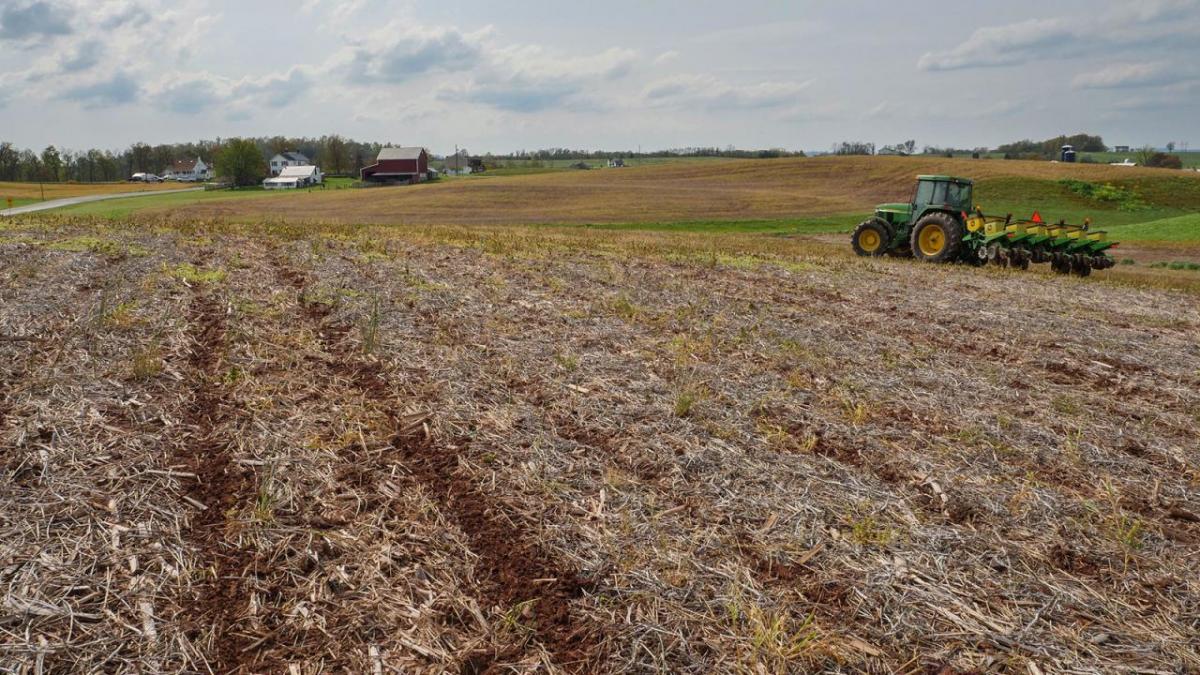Preston Keres, USDA (Flickr/Public Domain).
Agricultural land in Nebraska covers approximately 45.2 million acres across farms and ranches in the state. Major land uses on these operations include irrigated and dryland cropland, grazing, and hayland. Farmers and ranchers own almost 56%, or 25.3 million acres, across the state while absentee landowners own the remaining 44%, or 19.9 million acres. These acres are typically leased out by the absentee landowners referred to as landlords. Operator landlords account for 9% of leased acres and nonoperator landlords the other 35% of acreage rented out in Nebraska (Bigelow et al., 2016). Operator landlords may materially participate in lease agreements such as crop shares. Non-operator landlords include those who cash rent their land to operators.
The amount of farmland rented out across Nebraska varies from one county to another. Shown in Figure 1 is the percentage of leased farmland by county for Nebraska and surrounding states. Counties heavily engaged in row crop or small grain production tend to have a higher proportion of leased farmland (Bigelow et al., 2016). Areas in Nebraska, such as the eastern third and portions of the southern corridor of the state, have a higher percentage of leased farmland. Major ranching areas in the state, such as the Sandhills, along with parts of the western, northern, and central regions tend to have a lower percent of leased farmland.
Figure 1. Percent of Agricultural Land Rented by County in Nebraska and Surrounding States

Neighboring states, along with those in the corn belt, show similar trends to Nebraska with the proportion of farmland leased to agricultural operators. In the U.S., approximately 67% of landowners reside within 50 miles or less of their farmland, and 87% live within a distance of 200 miles or less from their properties (Callahan, 2021). Figure 2 provides a breakdown of the average distance absentee landowners live from their properties in the U.S. The majority tend to live in or near the agricultural state where the land may be located.
Figure 2. Average Distance Non-operator Landowners Reside from Their Agricultural Property in the United States

According to a survey conducted by the USDA-National Agricultural Statistics Service and analyzed by the Economic Research Service, 50% of non-operator landlords for Nebraska lived within about 13 miles of their property and 75% resided within no more than about 100 miles (Bawa and Callahan, 2021). Many of these owners may be retired farmers and ranchers or decedents from former operations. The farmland heirs may live in neighboring rural areas or large cities within driving distance of the property. These absentee owners may still have an understanding of agricultural considerations for the properties and challenges faced by the current operators.
Changing demographics of agricultural land ownership in the future may further fractionalize the number of owners. Also, future absentee owners may become more removed from the area or state in which the farmland may be held. Farmers or ranchers renting these properties face the challenges of keeping absentee landowners aware of current policies or production factors impacting their farmland. Designing equitable lease provisions should take into account the forces surrounding agricultural risk in crop or cattle production and uncertainty in commodity prices when renting farmland.
References
Bawa, S. G., & Callahan, S. (2021, April 2). Absent Landlords in Agriculture – A Statistical Analysis. Retrieved March 29, 2021 from the United States Department of Agriculture Economic Research Service: https://www.ers.usda.gov/publications/pub-details/?pubid=100663/.
Bigelow, D., Borchers, A., & Hubbs, T. (2016, August). U.S. Farmland Ownership, Tenure, and Transfer. Retrieved March 15, 2021 from the United States Department of Agriculture Economic Research Service: https://www.ers.usda.gov/publications/pub-details/?pubid=74675.
Callahan, S. (2021, April 2). Incidence of Absent Landlords Has Little Effect on U.S. Agriculture Real Estate Values, Research Shows. Retrieved April 5, 2021 from the United States Department of Agriculture Economic Research Service: https://www.ers.usda.gov/amber-waves/2021/april/incidence-of-absent-landlords-has-little-effect-on-us-agriculture-real-estate-values-research-shows/.
Jim Jansen is an extension educator and agricultural systems economist in the Department of Agricultural Economics at the University of Nebraska-Lincoln.
Jeffrey Stokes is the Hanson-Clegg-Allen Endowed Chair, Agricultural Banking and Finance, in the Department of Agricultural Economics at the University of Nebraska-Lincoln.
Jansen and Stokes author the annual Nebraska Farm Real Estate Market Report.


